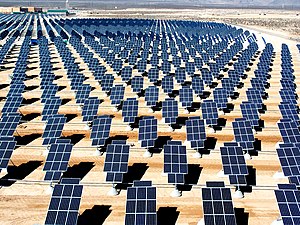
One involves pumping water uphill, the other one involves compressing air
Energy storage is the key to deploying wind and solar energy on a vast scale, but exactly how much of it will be required remains to be seen.
North America is windy. If the U.S. and Canada had enough wind turbines, they could produce all the electricity they need, and then some, from wind alone. The same is true of solar energy, with even bigger power surpluses. The U.S. Southwest’s deserts get enough sunlight to sustain the country’s thirst for electricity—20 times over. But both these sources are inherently erratic: winds wane and clouds show up with little notice. Wind, moreover, tends to blow harder at night, when demand for electricity is at its lowest.
According to the U.S. Department of Energy, when intermittent sources such as solar or wind reach about 20 percent of a region’s total energy production, balancing supply and demand becomes extremely challenging: rolling blackouts can sometimes become inevitable. The same problem exists elsewhere, notably in Germany, where a vast photovoltaic capacity has sprung up thanks to generous subsidies.
Burton Richter, a physics Nobel laureate who was on a recent panel that studied California’s power supply situation, told The New York Times blogger Andrew Revkin that because of intermittency, utilities would need to keep fossil fuel–burning plants as a backup that can quickly ramp up generation as need be. This large-scale load following, as it is called, “can only be done with natural gas,” Richter told Revkin.
Of course, if a statewide lull in wind were to last several days, California could buy electricity on the interstate market, as it often does. Proposals for a continent-wide supergrid that can ferry large amounts of power coast to coast are in part predicated on the idea that “the wind always blows somewhere.” Also helpful would be to make the grid smarter, so that users, prompted by dynamic pricing, would buy the energy they need when it is abundant and dial down their use when the cost goes up.
Experts, however, are increasingly skeptical that even supergrids or smart grids would suffice to cover the intermittency of wind and solar power. The solution, they say, must include storing massive amounts of energy for later use. Ideally, the U.S. could build a really gigantic battery and be done with it. But we are talking gigawatts (billions of watts) of power, and such a battery would be prohibitively expensive, at least with current technology.
Fortunately, two types of large-scale energy storage exist that are already mature and economically feasible—and some more futuristic ones are also promising—as I describe in the article “Gather the Wind,” in the March 2012 issue of Scientific American. These two technologies are less flashy than the ones the media usually likes to cover—they are decidedly “more Flintstones than Jetsons,” as one online trade journal put it. One involves pumping water uphill, the other one involves compressing air.
Read more . . .
Bookmark this page for “Grid energy storage” and check back regularly as these articles update on a very frequent basis. The view is set to “news”. Try clicking on “video” and “2” for more articles.







